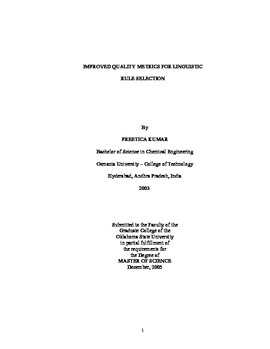| dc.contributor.advisor | Rhinehart, R. Russell | |
| dc.contributor.author | Kumar, Preetica | |
| dc.date.accessioned | 2014-04-16T03:07:26Z | |
| dc.date.available | 2014-04-16T03:07:26Z | |
| dc.date.issued | 2005-12-01 | |
| dc.identifier.uri | https://hdl.handle.net/11244/9642 | |
| dc.description.abstract | The objective of this study was to explore improved robust metrics for the selection and evaluation of linguistic cause and effect rules and to predict future outcomes to some extent. A hot and cold water mixer simulator was used to generate the data which was then processed to incorporate temporal information about the process. After the data was fuzzified, an exhaustive search produced the initial rule database. A Truth Space Diagram (TSD) was then generated for each rule. The first metric "Merit" was calculated based on the number of "trips" made by each rule into Quadrants II, IV of the TSD. This metric was used to select the best rules, along with a minimum corroboration criterion. The second metric "Expectation" was determined from historical data to predict the expected truth of consequent given the truth of antecedent, for new data. Histograms were used to denote the absolute and normalized expectations. The concept of using "trips" into the quadrants helped isolate independent events in the data and corroboration. Thus rules could be termed good or bad with more certainty. The metric "Merit" was very simple to calculate, did not require normalization, and was independent of the total number of points in the data-set. The two selection criteria proposed were found to select good and only good rules. The metric "Expectation" was used to determine the certainty of a selected rule's prediction, with a confidence limit of 95%. Adding noise to the data did not affect the efficiency of the selection procedure. Thus, the final rule database consisted only of the best rules. Truth of the consequent was successfully predicted based on historical data. | |
| dc.format | application/pdf | |
| dc.language | en_US | |
| dc.publisher | Oklahoma State University | |
| dc.rights | Copyright is held by the author who has granted the Oklahoma State University Library the non-exclusive right to share this material in its institutional repository. Contact Digital Library Services at lib-dls@okstate.edu or 405-744-9161 for the permission policy on the use, reproduction or distribution of this material. | |
| dc.title | Improved Quality Metrics For Linguistic Rule Selection | |
| dc.type | text | |
| osu.filename | Kumar_okstate_0664M_1686.pdf | |
| osu.college | Engineering, Architecture, and Technology | |
| osu.accesstype | Open Access | |
| dc.description.department | School of Chemical Engineering | |
| dc.type.genre | Thesis | |
| dc.subject.keywords | fuzzy rules | |
| dc.subject.keywords | metrics | |
| dc.subject.keywords | truth space diagrams | |
